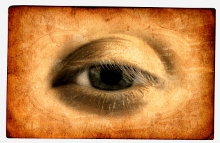A magazine where the digital world meets the real world.
On the web
- Home
- Browse by date
- Browse by topic
- Enter the maze
- Follow our blog
- Follow us on Twitter
- Resources for teachers
- Subscribe
In print
What is cs4fn?
- About us
- Contact us
- Partners
- Privacy and cookies
- Copyright and contributions
- Links to other fun sites
- Complete our questionnaire, give us feedback
Search:
Would Da Vinci Code?

Leonardo Da Vinci was born in the Tuscan town of Vinci, the illegitimate son of a local lawyer. Most people know his works of art. His two masterpieces the Mona Lisa in the Louvre and The Last Supper in Milan were some of the few works he actually finished. He was a perfectionist and kept going back to his work to try and improve it. For centuries Da Vinci was thought of mainly as an artist, but his world-changing approach to realistic painting was only possible due to Leonardo's fascination with science.
New Graphics Tools
Leonardo realized that to create lifelike paintings he had to understand how light and the eye worked, how shadows were cast, how the body moved, how light reflected off surfaces. In fact he wanted to understand how to represent the world graphically. These are exactly the sorts of things today's computer graphics researchers need to consider. While computer graphics creates new ways to give life-like images on electronic screens, Leonardo developed new ways to apply paint to canvas, to build up the exquisite optical effects he observed.
He Robot
He took this fascination with understanding and recording the world around him to extreme lengths, dissecting many bodies and drawing them in great detail. He saw the body as a machine, a complex mechanism that could eventually be understood. He was one of the first to identify the pumping action of the heart. He even replaced muscles with strings to experiment and see how they worked with the levers of the bones. His understanding of anatomy and his experimental approach opened the ways for others to follow in later centuries. He also created the first ever designs for a humanoid robot, 'The Robot Knight', based on the anatomical ideas he had developed. Centuries later the design was simulated on a computer and was shown to work.
Engineer and Inventor
Robot design wasn't Leonardo's only invention; he is credited with designs for the first parachute, flying machine, crane, clocks, the horseless carriage, tank and drilling machines. Many of his ideas were before their time, the materials and power sources had yet to be invented to make them a reality. A few of them would sadly never have worked, however his creativity was clear and unbounded. His mind blended art and science, and his journals, which he wrote daily, encrypted in his left-handed mirror script to protect them from prying eyes, show ease with switching from one to another.
Problem Solver and Computational Thinker
Leonardo loved to solve difficult problems, the flight of birds, the movement of a horse, the realistic depiction of skin tone. He was an abstract thinker, and would often take an idea from one area, distill out the important parts, and apply these to another different area. He used analogy, for example he wrote short fables like Aesop, stories that seemed to be to entertain children but were in fact to communicate to adults the danger of greed and so on. In today's world we would say he showed all the skills of a Computational Thinker. Many would argue that if he was alive today Leonardo would be a Computer Scientist. Certainly his interest in understanding the world and building creative new ways to describe, record and manipulate it are central to computer science. His abstract problem solving mind would have made him an excellent computer programmer, if there had been any computers around to program. Not surprisingly he had thought of computers too and had designed a gear-driven calculating machine. Sadly it was never built. If it had been we could perhaps have seen some of the real Da Vinci Code.


